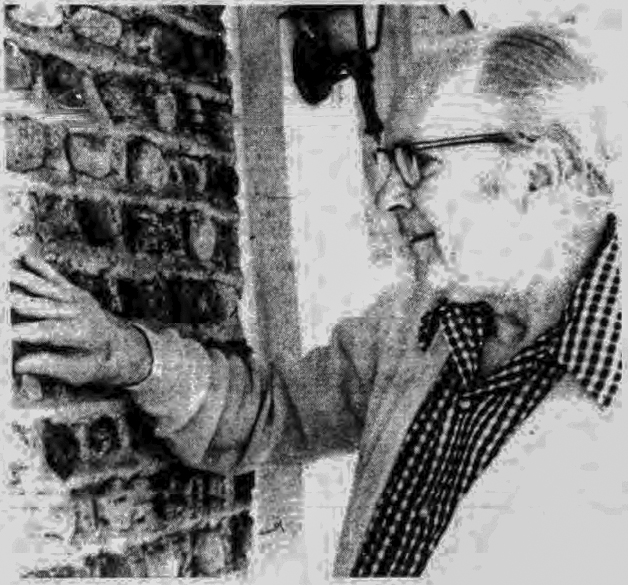
Bob Roudabush believes it's what's up front that counts. That's one of the reasons why he is compiling a comprehensive photo record of the front walls of cobblestone buildings in New York State. "The master mason worked on the front wall," Roudabush explained, "so that's where the best work is found. Frequently the stones on the front wall are smaller, more uniform and better mortised (cemented together) than those on side or rear walls, built by apprentice masons."
Roudabush has already spent three years working on his project, and has pinpointed at least 560 structures he expects to photograph. So far, he has photographed 96 in Monroe County, 150 in Wayne County, 96 in Orleans, and fewer numbers in Ontario, Yates, Wyoming, Niagara, Genesee, Livingston and Seneca counties. He says he will keep the photos for his own pleasure during his lifetime, and leave the problem of their permanent disposal to his wife. He would like to have the collection given to a library¹ or similar place where the public can have access to It.
The retired Eastman Kodak toxicologist uses five cameras to photograph each house. First, he takes a long distance shot, from across the lawn, to establish patterns of sunlight. Close up photographs are taken of the building's corners, to determine whether the cornerstones are limestone or some other material, the number of courses per quoin (cornerstone) and style of mortising. Other photographs are of the lintel or stones over the windows, and doorway, and of the color pattern of the stones. All the photographs are in color. In addition, Roudabush takes color slide transparencies. Roudabush's wife, Dorothy, keeps accurate records of the starting and stopping numbers on the film in each camera at every stop, to enable Roudabush to match the pictures later on.
Trips are easy day drives from Roudabush's home in Rochester; one recent weekend jaunt concentrated on cobblestone homes in the Junius and Waterloo area. For longer trips, such as to the octagonal cobblestone inn and homes in Madison County, the Roudabushs will take a vacation, staying in Holiday inns along the way. Many hours are spent researching each route, drawing on information in the authoritative books by Carl F. Schmidt, Cobblestone Architecture and Cobblestone Masonry. Roudabush also contacts the historical society in each county to learn of any structures he may have missed, and to request a map of the county which he will use to prepare a detailed plan of each journey.
Roudabush's photo collection is designed to supplement information in Schmidt's books. He is only concerned with the type of stone used for quoins, the type of cobblestone, and the style of mortising. Roudabush says he can tell if the same mason worked on different buildings from the style of the mortising, although the names of the cobblestone masons have been forgotten. Sometimes, buildings were built with no master mason. There is a Masonic Temple in Warsaw, Wyoming County, and a church in Monroe County which appear to have been built by the members. "The shorter members laid the bottom courses, taller members the upper ones. One man laid a section so high and so wide up the middle. The styles changed with every mason. The effect is Iike patchwork." Roudabush explained.
Although most of the cobblestone structures have withstood the passage of time, some have suffered from their owners. Clumsy attempts to patch the limestone mortar have disfigured some structures, and one cobblestone house in Orleans County has been painted white. Cobblestone houses are not all Roudabush collects. Before them, he compiled a photographic record of all public covered bridges from Maine to Virginia and west to mid Ohio, and of lighthouses along the shore from New York City to the top of Maine. Several of these structures have been destroyed since Roudabush photographed them, leaving his pictures as the only record for future scholars.
Roudabush said he first started photo collections as a point for his vacation. "It gave us something to do, some definite place to go. I wanted to learn something, and so I started with something I didn't know about. The lighthouses, covered bridges and cobblestone buildings are all structures which Intrigue me," he explained.
Bob Roudabush, who is compiling a photo record of the front walls of cobblestone buildings in New York State, examines a house in the Town of Junius in Seneca County. (Times photo by Doris Wolf)